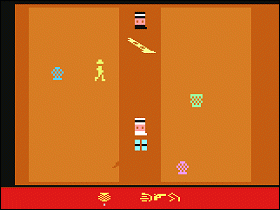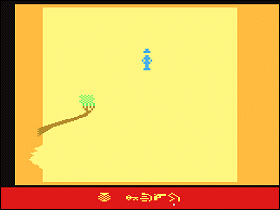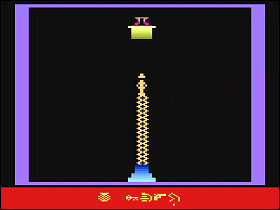 The Game: You’re guiding a pixellated rendition of famed adventurer Indiana Jones as he embarks on his search for the Lost Ark of the Covenant. Meander through Middle Eastern marketplaces, obtain weapons and items of value, and watch out for snakes as you try to overcome a series of obstacles and hazardous environments, find the clues, and recover the Ark. (Atari, 1982)
The Game: You’re guiding a pixellated rendition of famed adventurer Indiana Jones as he embarks on his search for the Lost Ark of the Covenant. Meander through Middle Eastern marketplaces, obtain weapons and items of value, and watch out for snakes as you try to overcome a series of obstacles and hazardous environments, find the clues, and recover the Ark. (Atari, 1982)
Memories: One of the two movie licenses that landed on programmer Howard Scott Warshaw’s desk, the Atari 2600 game Raiders Of The Lost Ark is a near-perfect specimen of an adventure game on this console: it makes sense from reading the manual, but in practice, the way in which the game’s various settings and characters interlock and interact is almost abstract. Maybe this is one of those games where I’m just not getting the point, but I’ve always wondered why E.T. is held up as an example of what not to do with a 2600 game, and Raiders is held up as an example of a great game – to me, they’re almost identical.
 Even armed with the original game manual in my hands, Raiders can be a frustrating exercise. In some cases that’s just the limitation of the machine it runs on: I’m not a big fan of using one joystick to select your item/weapon and another to actually move and fire, but I’m not sure there’s a better way that this could’ve been implemented on the 2600. But in some cases, those limitations suck the heart out of the game. If you hand me a game cartridge with Indiana Jones on the label, I’m expecting to go around with a whip in one hand and a revolver in the other, and maybe a rucksack full of treasure. Raiders – the game – does not deliver on that experience, instead offering an adventure game whose play mechanics border on total abstraction.
Even armed with the original game manual in my hands, Raiders can be a frustrating exercise. In some cases that’s just the limitation of the machine it runs on: I’m not a big fan of using one joystick to select your item/weapon and another to actually move and fire, but I’m not sure there’s a better way that this could’ve been implemented on the 2600. But in some cases, those limitations suck the heart out of the game. If you hand me a game cartridge with Indiana Jones on the label, I’m expecting to go around with a whip in one hand and a revolver in the other, and maybe a rucksack full of treasure. Raiders – the game – does not deliver on that experience, instead offering an adventure game whose play mechanics border on total abstraction.
 What’s sad is that the game seems to have a lot going for it – some of the 2600’s most flicker-free graphics, a respectable attempt at translating John Williams’ “Raiders March” into something that the
What’s sad is that the game seems to have a lot going for it – some of the 2600’s most flicker-free graphics, a respectable attempt at translating John Williams’ “Raiders March” into something that the  2600 can just about sonically handle, and relatively smooth control, but when all of those elements are only in service of a confusing game that shares the name – and not much else – of one of the all-time greatest “popcorn” movies, it’s hard not to feel cheated. There’s almost more “game” to be had in E.T., to be blatantly honest.
2600 can just about sonically handle, and relatively smooth control, but when all of those elements are only in service of a confusing game that shares the name – and not much else – of one of the all-time greatest “popcorn” movies, it’s hard not to feel cheated. There’s almost more “game” to be had in E.T., to be blatantly honest.